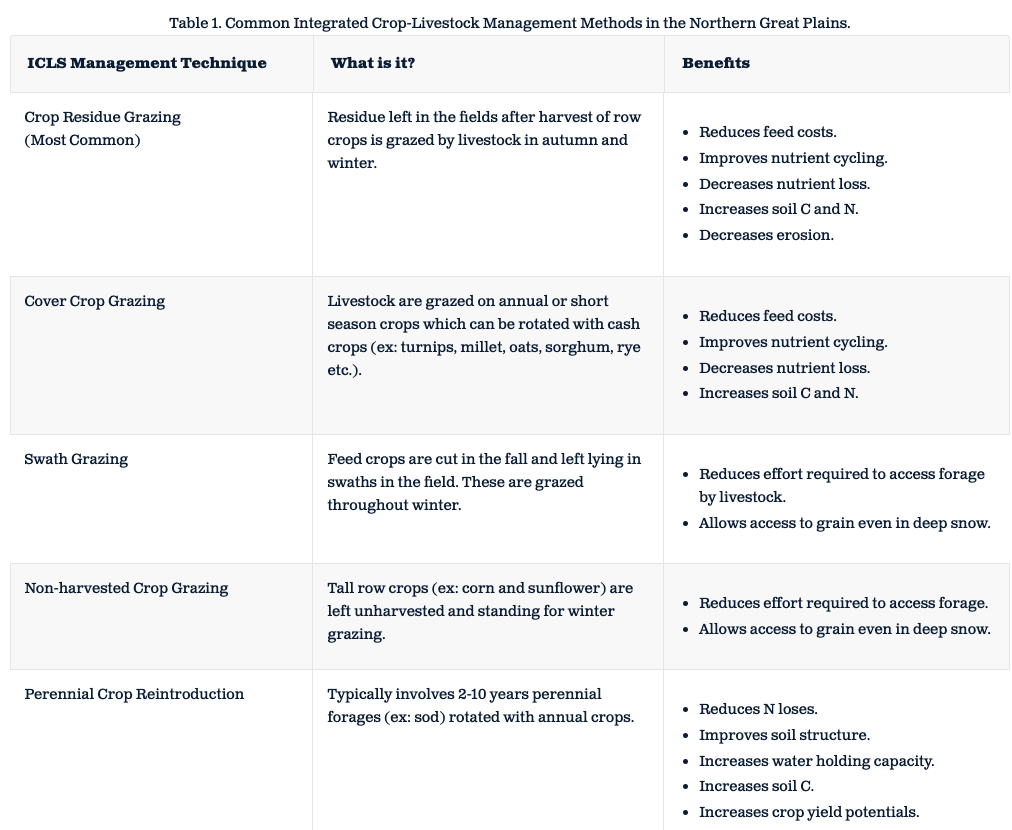In the last 100 years, many producers have become specialized and highly efficient at producing specific crops or livestock. This has helped to meet demand as the global population continues to grow. However, increasing specialized production can result in soil degradation, unsustainable resource use, and chemical, antibiotic, and hormone contaminations. An integrated crop-livestock system can provide an alternative management strategy that benefits producer’s income, soil health, and the environment, all while increasing production. Researchers at South Dakota State University reviewed recent studies involving common integrated crop-livestock system (ICLS) management methods in the Northern Great Plains. They then compiled the impacts ICLSs had on crop performance, livestock performance and economics.
What is an Integrated Crop-Livestock System (ICLS)?
An Integrated Crop-Livestock System (ICLS) is a system that manages both crop and livestock production so that products are used to support each other. This can take place on a single farm or among farms in a region. These systems recycle nutrients from livestock waste back to croplands and, through fodder production, also improve soil organic matter and fertility. These can be implemented in a variety of ways. ICLS implementation methods are selected by producers based on local conditions. A list of common methods in the region and their benefits is included below.

As shown above, ICLS practices influence crop production through impacting soil properties. ICLSs affect soil surface exposure, erosion, and soil organic carbon. Because of these effects, researchers have seen an overall increase in grain yields and weed control when compared to conventional tillage. These improvements not only help soil health but can also lead to decreased costs and increased productivity.
Impacts on Livestock Performance
ICLS practices influence livestock performance by impacting nutrient availability, net gains, and providing grazing in autumn and winter. Researchers found that gains in livestock vary based on season, forage selected, and management of producers. However, implementing these systems significantly reduced costs for producers, especially in the winter months, and resulted in better pest control.
Economics
Integrated crop-livestock systems help producers “do more with less” and increase efficiency. Livestock in these systems have the potential to convert low value crops to high value proteins, increasing farm returns. These systems also reduce risk for producers by spreading them over multiple enterprises.
Challenges with Implementing ICLSs

Implementing integrated crop-livestock systems can be a complicated process as producers are often more comfortable with traditional production methods. As with any new management practice, implementing an ICLS can initially increase day-to-day work loads and require some resource investment. There is currently also a lack of knowledge and management skills about their implementation. However, with proper implementation ICLSs can be highly beneficial to producers.
Bottom Line
Integrated crop–livestock systems positively affect crop production by improving soil health and enhancing crop production. In these systems, livestock performance is impacted by season, forage selection, and management but ICLS have been shown to decrease costs for producers. Overall the adoption of ICLSs can increase economic benefits and reduce economic risks for producers. This leads to enhanced farm productivity and food security.




Post a comment
Report Abusive Comment